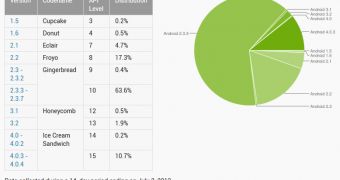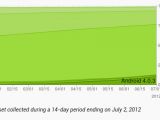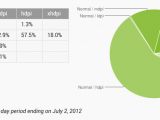Google is moving forth with adding new functionality to its Android platform, and has unveiled the latest version of the OS, Jelly Bean, only last week.
However, it will still take a while before this platform release makes it to the market, and all eyes are currently on the Android 4.0 flavor of the mobile operating system, which was launched in fall last year under the name of Ice Cream Sandwich.
The platform has shown steady growth during the past months, and is currently loaded on 10.9 percent of all active Android devices out there, the latest info from Google shows. Last month, it was present on only 7.1 percent devices.
The report is based on data collected in the two weeks ending on July 2nd, 2012, and reflects the percentage of handsets and other devices that have been accessing the Google Play Store in the timeframe.
The graph that Google published on its Android Developers portal shows that 10.7 percent of all active devices run under Android 4.0.3 - 4.0.4, while 0.2 percent of them are powered by 4.0 - 4.0.2.
Moreover, it also shows that Gingerbread, the platform version that preceded Ice Cream Sandwich, is currently powering only 64 percent of active devices, down from 65 percent last month.
63.6 percent of the hardware runs under Android 2.3.3 - 2.3.7, while 0.4 percent was loaded with 2.3 - 2.3.2.
Honeycomb, the platform release designed specifically for tablet PCs, is currently loaded on 2.4 percent devices. Android 3.1 powers 0.5 percent tablets, while Android 3.2 is present on 1.9 percent of them.
The older Android 2.2 Froyo is currently featured on 17.3 percent of all active Android devices out there, while its predecessor, Android 2.1 Éclair, still runs on 4.7 percent handsets.
Moving further down the line, we have Android 1.6 Donut on 0.5 percent of handsets and Android 1.5 Cupcake on 0.2 percent of them.
This data is meant to help application developers make an idea on the different OS variants that are being actively used out there, so that they would be able to design their apps so as to better target specific devices.
Some additional info on the use of these platform flavors is also available on said website, including a historical distribution of the releases, screen sizes and densities available on devices, and the support for particular versions of OpenGL ES.

 14 DAY TRIAL //
14 DAY TRIAL // 

